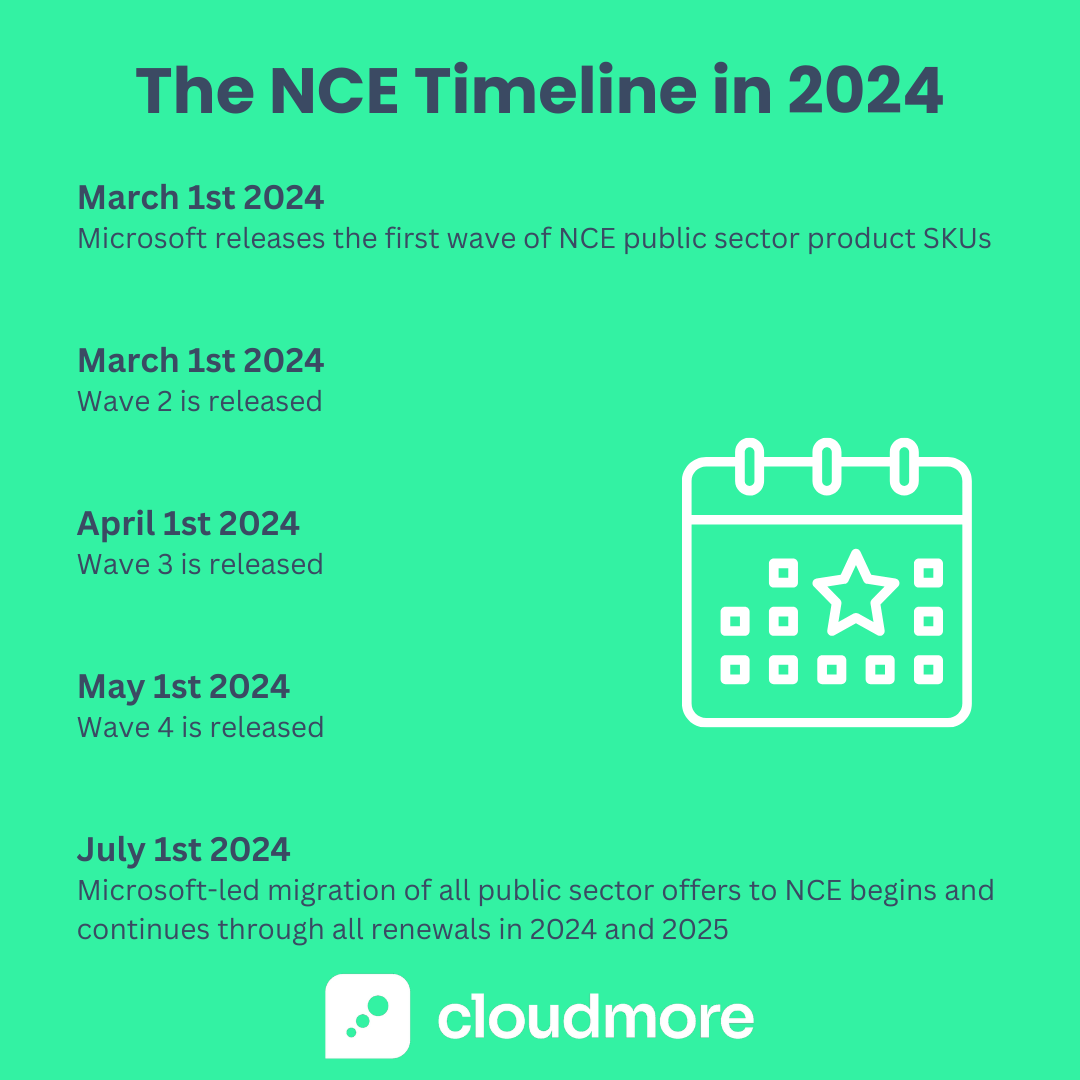Microsoft New Commerce Experience: A Complete Guide
Microsoft's New Commerce Experience (NCE) has emerged as a pivotal innovation, reshaping how businesses approach Microsoft's products and services.
Since its initial rollout for Azure in 2019, and its adoption for seat-based cloud subscriptions in 2022, NCE has fundamentally altered the landscape of software licensing. It offers Microsoft partners enhanced flexibility and strategic control over subscription management.
Understanding NCE is crucial for any business leveraging Microsoft products.
It's not just about adapting to a new subscription model; it's about aligning with a more streamlined, cost-effective way of managing digital tools.
This article delves into the essence of NCE, offering a comprehensive guide on how to navigate this new terrain. From exploring the flexibility in subscription models to understanding the strategic implications of license management under NCE, we cover all you need to know.
Decoding NCE
Straight from the outset, we’ve covered what the acronym NCE means. Let’s now break down when it was launched, the features it offers to Microsoft partners, and that state of play as we head into 2024.
What is NCE?
Microsoft NCE is a significant evolution in how businesses and partners interact with Microsoft's suite of products and services.
-1.png?width=799&height=799&name=What%20is%20NCE%20(2)-1.png)
Initially launched in 2019, NCE represents a shift towards a more flexible, streamlined approach to purchasing and managing Microsoft subscriptions like Microsoft 365, Dynamics 365, Windows 365, and the Power Platform.
Key Features of Microsoft NCE
Microsoft NCE introduces several notable features and benefits:
- Flexibility in Service Management: NCE offers enhanced control over subscription renewals and the ability to schedule changes effectively at the end of terms.
- New Pricing and Add-On Options: It provides more flexible ways to acquire add-on services and new monthly term options, adding versatility for businesses.
- Simplified Billing: Billing in NCE is streamlined, with options for monthly, annual, or three-year terms and corresponding billing cycles.
- Enhanced Partner Incentives: Microsoft offers incentives for more than 400 SKUs in NCE, supporting partners as they transition customers to the new experience. However, legacy incentives for commercial SKUs were discontinued at the end of 2022, with public sector SKUs to join them, likely in 2025.
-1.png?width=799&height=799&name=NCE%20vs%20Legacy%20Comparison%20(2)-1.png)
Evolution since 2022 and its current state in 2024
Since its introduction in 2022, NCE has been on a continuous path of evolution, simplifying the complexity traditionally associated with managing Microsoft licenses, for example in allowing alignment of the end dates of subscriptions for more streamlined billing. It also provides cost savings, especially for annual and multi-term subscriptions.
In 2024, the public sector, including Education and Government licenses, will be fully integrated into the NCE, marking a significant milestone in its adoption across all sectors.
How NCE Simplifies Microsoft’s Service Offerings
NCE simplifies Microsoft’s service offerings in several ways:
- Streamlined Subscription Options: Offering monthly, annual, and 3-year subscriptions, NCE allows businesses to choose the model that best fits their needs, balancing flexibility and cost savings
- Transparent Pricing and Promotions: Clear distinctions in pricing between different subscription terms and promotional offers make budgeting and financial planning more straightforward.
- Ease of Subscription Management: The ability to manage subscriptions more flexibly, including scheduled changes, cancellations, and seat adjustments, aligns better with dynamic business requirements.
Microsoft NCE is a transformative approach, offering enhanced flexibility, simplified billing, and improved service management.
This evolution marks a significant shift in how businesses and partners interact with Microsoft’s offerings, paving the way for more efficient and cost-effective software management strategies.
Transition to NCE
While most Microsoft subscriptions are now using NCE, the switch is still upcoming for the public sector, as mentioned previously. Here you can learn about the processes and challenges that come with making the upgrade from Legacy.
Migration Process to NCE
Migrating to Microsoft's NCE involves several crucial steps, especially for partners managing license-based services like Microsoft 365, Dynamics 365, and Microsoft Intune.
Microsoft has announced some key dates regarding the new NCE segments features rollout.

This process is designed to offer more flexibility and capabilities in managing these services.
- Mapping Legacy Offers to NCE: Partners should review the NCE Mapping tab in the new commerce offer matrix to understand which legacy offers map to the new commerce product SKUs. This mapping is crucial for determining the correct migration path for a specific legacy offer.
- Migration Eligibility Check: Before initiating migration, it's important to verify if the subscription is eligible for migration. Microsoft-led migrations are applicable if there is a corresponding new commerce product SKU with compatible pricing. If a legacy offer doesn't have a corresponding eligible new commerce equivalent, it will eventually be retired.
- Partner Profile Verification: Ensure that the Partner Profile is in a valid state to allow migrations. This involves checking if the Partner of Record associated with the subscription is valid and active.
- Addressing Ineligibility Reasons: If a subscription is found ineligible for migration, partners must address the specific reasons, such as license limits, term and billing plan compatibility, or an inactive partner organization.
- Manual Migrations: For some offers not enabled for migration, partners may need to manually purchase the new commerce version, assign licenses appropriately, and then cancel the legacy offer.
- Utilizing APIs and Partner Center: Partners can use the Partner Center portal or APIs for migrations, ensuring that they have access to the most up-to-date pricing and offer information.
Common Challenges and Solutions during NCE Migration
- Challenge: Subscriptions ineligible for migration due to legacy offers not having a new commerce equivalent.
- Solution: Consult the CSP offer retirement guide for guidance
- Challenge: Incompatibility of terms and billing plans between legacy and new commerce.
- Solution: Manually migrate to new commerce after consulting the new commerce price lists and customer needs.
- Challenge: Limitations in the number of new commerce subscriptions allowed for certain product SKUs.
- Solution: Consult the new commerce offer matrix and manually acquire the subscription that best meets the customer's needs.
- Challenge: No active relationship between customer and partner organizations.
- Solution: Partners should work with the customer to restore the relationship and then migrate the subscription to new commerce.
- Challenge: Microsoft does not allow to migrate subscriptions in bulk
- Solution: On the Cloudmore platform, you can use the NCE bulk migration tool.
NCE's Impact on Businesses
NCE represents an opportunity for Microsoft partners to sell subscriptions with more simplicity, while also securing longer term revenue with less fear of sudden churn.
How Businesses Can Leverage NCE for Growth and Efficiency
Microsoft's NCE introduces significant changes to the licensing and subscription models for its products, impacting how businesses plan and manage their software needs.
The switch to NCE offers flexibility and control over subscription options, enabling businesses to adapt their software usage more closely to their operational needs.
For instance, the NCE provides three main subscription options: standard monthly subscription, 12-month subscription, and 36-month subscription.
The monthly option offers flexibility without a long-term commitment, allowing businesses to adjust their seat count and plans each month as needed.
Conversely, the 12-month subscription locks in pricing for a year, offering cost savings and protection from price increases.
However, with the added flexibility and efficiency, NCE does come with some stricter rules. Cancellation is only available for the first 72 hours of an agreement, and after this you’ll be billed for your full term. You can suspend your subscription as an alternative but will still be billed.
You’re also unable to reduce your seat count during the term of your agreement. This is worth considering prior to subscription.
Changes in Subscription Management and Billing Under NCE
With the introduction of NCE, subscription management and billing have undergone considerable changes.
The NCE model emphasizes longer contract terms, with options for monthly, annual, and multi-year terms. While this model includes a monthly subscription option, it comes at a 20% premium, making it less attractive for businesses seeking flexibility.
The NCE model impacts how businesses handle their license counts. Under the new structure, license quantities can only be increased but not reduced during the subscription term, unless canceled within a specific window.
This change necessitates more strategic planning from businesses regarding their license needs to avoid unnecessary expenses.
NCE and Microsoft Partner Ecosystem
Microsoft’s partner network is crucial in providing their products to businesses globally and offering ongoing support throughout the length of their subscriptions. We’ll look here at how NCE will affect those partners and what they’ll need to be aware of before NCE becomes fully implemented.
The Role of Partners in Facilitating NCE Adoption
Microsoft partners play a critical role in facilitating the adoption of NCE among businesses.
They help clients understand the new subscription models, guide them through the migration process, and assist in optimizing their license management under the new terms.
Partners are also responsible for keeping their clients informed about the latest changes and opportunities within the NCE framework.
Benefits and Responsibilities for Microsoft Partners
For Microsoft partners, the NCE program offers new incentive opportunities and a more streamlined approach to selling and managing Microsoft products. The benefits for partners include:
- Enhanced Flexibility in Service Management
- New Pricing and Add-on Options
- Simplified and Enhanced Billing
- Sales Capabilities and Operational Efficiencies
- Multiple Term Options
- CSP Incentive Program Impact
However, this also comes with the responsibility of ensuring that their clients' transitions to NCE are smooth and beneficial. Partners need to be well-versed in the intricacies of the NCE model to advise their clients effectively on the best subscription options and strategies for maximizing their investment in Microsoft products.
It requires a strategic approach to software licensing and subscription management, emphasizing the importance of careful planning and understanding the long-term implications of subscription choices.
Businesses and partners alike must stay informed and adaptable to navigate these changes effectively.
Looking Ahead – NCE in 2024 and Beyond
By the time 2025 rolls around, NCE should be the standard for purchasing subscriptions from Microsoft. Let’s examine how this will impact businesses now, and in the coming years.
Future of NCE and Microsoft’s Vision
Microsoft's roadmap for NCE indicates a continued emphasis on simplifying and streamlining how businesses manage and purchase their cloud solutions.
Starting in January 2024, all existing commercial plans under the Cloud Solution Provider (CSP) will automatically upgrade to NCE on their respective renewal dates. This transition is part of Microsoft's strategy to address the complexities and costs associated with managing licenses, offering more tailored options for various purchasing scenarios.
The focus is on providing flexibility and supporting a range of purchasing scenarios to enable customers to buy more easily while optimizing costs.
The NCE plan includes term subscriptions that reward loyalty and commitment to Microsoft, standardizing offers and terms.
This shift represents not just a technical migration but a strategic opportunity for businesses and partners in the Microsoft ecosystem to leverage new efficiencies, pricing structures, and subscription models offered by NCE.
Tips for Businesses to Stay Ahead in the Evolving Digital Landscape
- Strategic Planning for Subscription Management: With the shift to NCE, it's crucial for businesses to assess their current and future needs carefully. Downgrading subscriptions or reducing license counts mid-term is not permitted under the NCE model, so planning ahead for the right level of service is essential.
- Leveraging New Pricing Structures: The NCE model offers different subscription terms, including monthly and annual options. Businesses should consider their operational flexibility and financial planning when choosing between these options, keeping in mind that monthly subscriptions come with a 20% cost increase.
- Staying Informed and Adaptable: Continuous education and staying informed about the latest developments in NCE will be key. Microsoft provides resources and training for businesses and partners to understand and navigate these changes effectively.
- Partner Collaboration: Working closely with Microsoft partners can provide valuable insights and assistance in managing the transition to NCE. These partners can offer strategic advice tailored to specific business needs and help optimize license management and cost-effectiveness under the new model.
- Exploring Incentive Opportunities: Microsoft offers various incentive programs within the NCE, such as the Microsoft Commerce Incentive (MCI) program. Businesses should explore these opportunities to maximize the benefits of their investment in Microsoft products.
As Microsoft continues to evolve its NCE, businesses need to stay proactive, informed, and strategic in their approach to software licensing and subscription management.
This will enable them to leverage the full potential of NCE for growth and efficiency in the ever-changing digital landscape.
Key Takeaways about Microsoft NCE
Microsoft NCE marks a significant shift in how businesses engage with Microsoft's cloud services and software subscriptions.
Here are some key takeaways to help you navigate and leverage NCE effectively:
- Flexibility and Choice in Subscriptions: NCE introduces flexible subscription models, including monthly and annual options. The monthly subscription offers operational flexibility with a 20% premium, while annual subscriptions lock in cost savings and price stability.
- Strategic License Management: Under NCE, the ability to downgrade subscriptions or reduce license counts mid-term is restricted. This calls for strategic planning to ensure you’re aligned with the long-term needs of your customers.
- Enhanced Partner Collaboration: Microsoft partners play a pivotal role in facilitating the transition to NCE. They offer strategic advice and help in optimizing license management under the new model, making them valuable allies in this journey.
- Incentive Opportunities: Explore incentive programs like the Microsoft Commerce Incentive (MCI) program within NCE. These incentives can enhance the benefits and ROI of your investment in Microsoft products.
- Commitment to Future Growth: Embracing NCE is not just about adapting to a new licensing model; it's about aligning with Microsoft's vision for a more streamlined, efficient, and cost-effective way to manage cloud services and software subscriptions.
- Staying Informed and Adaptable: Continuous learning about NCE will be crucial. Microsoft provides various resources and training to understand and effectively navigate these changes.
In conclusion, Microsoft NCE presents an opportunity for businesses to streamline their cloud services and software subscriptions, aligning with a more modern and efficient approach.
By embracing NCE, your business can benefit from improved flexibility, strategic license management, and partnership opportunities, all of which are key to thriving in the evolving digital landscape.
Share this
You May Also Like
These Related Stories

Demystifying Microsoft's Coterminosity for MSPs in the New Commerce Experience

Microsoft’s CSP Shake-up: How Top MSPs Can Turn Requirements into Competitive Advantage



